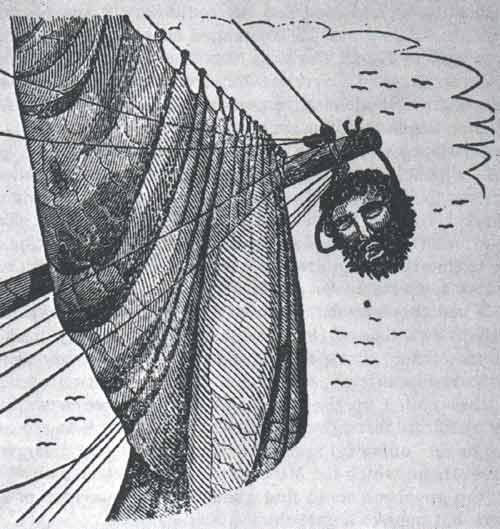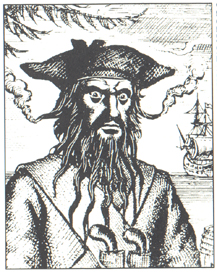
BLACKBEARD
16?-1718
|
All hail the most notorious
pirate to ever maraud the eastern shores! |
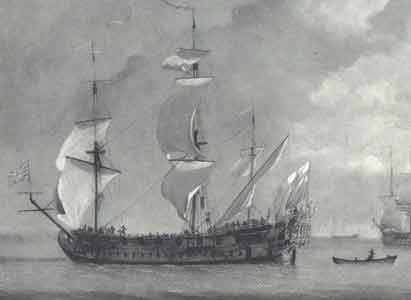
|
Little Eddie Teach went to sea at an early age, signing on with the British Navy. For an undetermined number of years he fought in the Queen Anne Wars against Spain, distinguishing himself as a proficient sailor and expert shot. These years gave him invaluable experience on how the English fought their ships and ran their crews--experience he would one day use against them. The war ended in 1713 and around this time Teach left the British for the life as a "Brother of the Coast", a loosely-mixed bag of captains, crews, and hangers-on that had founded a community based on freebooting. Pirate ships ranged from Newfoundland to South America, and their unofficial capitol was New Providence, now known as Nassau. The wars with the Spanish and a terrible earthquake (which had flattened the city) had eroded England's power in the region and for a time the pirates had undisputed control of this lush tropical port. It was a high time for the Brethren, and New Providence was a haven for one and all. Stolen goods packed the holds of incoming ships and pirate crews lavishly spent money on booze, food, and especially women. Many people slept outdoors in hammocks or in huts made from palm leaves. They roasted whole pigs on the beach and were never far from "the punch bowl", a intoxicating combination of rum and whatever fruit juices were at hand. Soon they would be broke and would return to the sea in search of loot. Here Teach met Captain Benjamin Hornigold, one of the most respected (and feared) pirates of the West Indies. Teach joined his crew in 1716. Teach had a knack for hand-to-hand combat, and his tolerance for liquor was unmatched. Plus he was educated and physically intimidating. Before long he was captaining his own smaller boat as consort to Hornigold, and together the two began a profitable campaign that soon had tongues wagging with tales of their larcenous exploits. With his finances and social status much-improved, Blackbeard set about more ambitious goals. A good-sized stone tower was either taken over or built outside of town, and was used as his base. It's remains still survive. In between cruises he and his favored mates would be there, lounging in tents set up around the tower, quaffing rum, roasting meat, and planning their next voyage. In the spring of 1717 Hornigold and Blackbeard left New Providence for the shipping lanes of the Colonies and the prizes that sailed them. By the end of this cruise they had taken many ships including the sloop Concord, a large French merchantman. Blackbeard saw his chance. He asked Hornigold if he could have the ship as his own and the older pirate agreed readily. Hornigold was by that point very wealthy and desired to take advantage of a pardon being offered by the King. Plus he probably realized he had no choice in the matter. He was being offered a courtesy as Blackbeard no doubt intended to take the ship anyway. |
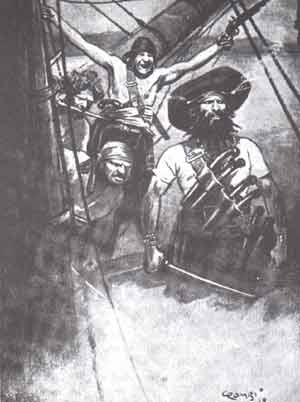
|
At this point in his life, Blackbeard was about 35 years of age. By all accounts he was an awesome physical specimen to behold. Standing well over six feet tall, he must have dwarfed most men. His build was not overly large but he was said to be immensely strong. Besides his height his most obvious feature was his beard, which grew "up to his eyes" and was of tremendous length and breadth. He would twist and braid it into black ribbons and then tuck them behind his ears. But it was during battle that Blackbeard was at his most fearsome. Across his chest he would wear a belt that held multiple matchlock pistols; thus he could have several loaded guns ready in an instant. The burning fuses used to light the pistols were tucked beneath his hat, creating large clouds of sulfurous smoke which made it seem as if he was afire. A broad leather belt supported a further lethal array of hand weapons which would have included swords, axes, daggers, and more pistols. He often used a huge musket with which he was a deadly shot. Blackbeard carefully cultivated his appearance and persona to inspire maximum awe in his followers and maximum terror in his victims. Pirates and sailors tended to be a supernatural lot and Blackbeard played on this by constantly invoking the devil in his oaths and curses. The Concord was renamed The Queen Anne's Revenge and refitted with 40 guns. Soon Blackbeard was back at sea, taking two large merchantmen in early 1718. The modis operandi was always the same. The Queen Anne would site potential victims and then begin to maneuver closer to them, trying to ascertain their quarry's value and ability to defend itself. If the target was tempting the ship would close, and haul up either a black or red flag emblazoned with their evil-looking symbol. The meaning of the flag was clear--surrender or die. The sight of a well-armed warship crowded with fearsome looking men brandishing their weapons must have been a terrifying one for a merchant crew. This was the standard pirate tactic--make the threat of violence so horrifying that your victims would surrender rather than resist. Most of the ships Blackbeard took were merchant ships packed with cargo and manned with skeleton crews. Some merchantmen were heavier and armed with cannon but few men would dare stand against Blackbeard. Making the option of surrender more attractive was that Blackbeard was good for his word. Captives were treated fairly as long as they didn't resist. There are no records of Blackbeard maiming or murdering any captives who submitted to him, and women in particular were treated with respect and care. There are however numerous examples of Blackbeard bringing murderous abuse on those that opposed him. A few days after taking a large and well-armed merchant man the Queen Anne encountered the Scarborough, a British man-of-war. A running battle developed and over the course of the next few hours Blackbeard's gunners out-dueled and severely damaged their rivals, who were forced to withdraw. Defeating a military ship was unheard of for a pirate vessel and this incident did much to enhance Blackbeard's image. After this episode he may or may not have gone to Bath, NC, to take advantage of a pardon. Whether he did so or not matters little as he immediately returned to his piratical ways. He met up with fellow "Brother of the Coast" Stede Bonnet and soon Blackbeard had built an entire flotilla of pirate ships under his command. They continued to take prizes seemingly at will. Then in May, 1718, the Queen Anne and her consorts hove into view off the port of Charleston, SC, much to the alarm of the local populace. For several days they simply stopped and looted every ship that tried to pass in or out of the harbor. In doing so they took several important hostages. Delegates were sent ashore and finally a ransom was worked out (a trunk of medical supplies), but not before the entire town had been terrified and humiliated. |

|
Blackbeard was at the height of his power. He had over 300 men under his command and the boats were full of loot. But bad luck overtook him. The Queen Anne and another ship were lost on a sandbar in Beaufort Inlet, North Carolina. Many men were marooned on a deserted island nearby. Whether or not this was treachery on Blackbeard's part is up for debate, but the end result was Blackbeard slipping away with the remaining ship, The Adventure, along with his best crew and most of the loot. Of his abandoned cohorts, most were saved and regrouped under the command of Stede Bonnet, "The Gentleman Pirate". They swore revenge against Blackbeard but were captured by a force of ships commissioned by the Governor of South Carolina to hunt pirates. Stede Bonnet and most of his men were hung at Charleston, the very port they had helped blockade just months earlier. |
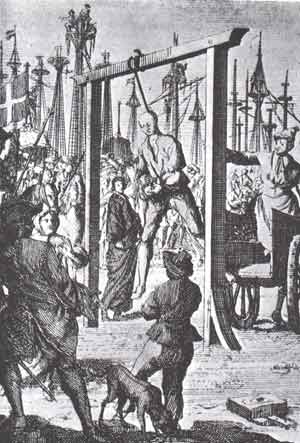
| THE DEATH OF STEDE BONNET |
|
Meanwhile Blackbeard and his men had landed in Bath, North Carolina, to divvy up the loot and plan their next move. Blackbeard wasted no time. He met with his friend, Governor Eden, and soon had not only a pardon but a beautiful home and young bride. His pirate cronies scattered over the county and for a time it seemed like Blackbeard was retired. But he still controlled the waterways of the North Carolina coast, and in the summer of 1718 held a huge pirate's gathering at Ocacroke Island, a favorite haunt. Among those in attendance was Charles Vane "the Insane", a merciless captain who had once hung captives from the rigging as the ship was set alight. The party lasted for days as the pirates and their guests ate and drank themselves into a series of comas. Rumors of Blackbeard's continued presence in the region infuriated Governor Spotswood of Virginia, who was also critical of Governor Eden's apparent sponsorship of this notorious pirate. Spotswood began to collect intelligence and soon apprehended a former mate of Blackbeard's who was compelled to divulge the locations of Blackbeard favorite spots in North Carolina. Soon an armed expedition had been mobilized and charged with the mission of killing Blackbeard. |

| TEACH'S HOLE, SIGHT OF BLACKBEARD'S DEATH |
|
At sundown on Nov. 21st, 1718, two ships, both flying the British flag, approached Beaufort Inlet from the north. They were armed sloops under the command of Lieutenant Robert Maynard, and aboard the boats were close to 60 soldiers. As night fell the men could see the mast of Blackbeard's ship, The Adventure, sticking up over an intervening sand dune. Maynard blockaded the inlet and waited for the morning to launch his attack. A lookout had spotted the approach of the sloops and Blackbeard prepared his ship for battle. The sloops drew within hailing range, and Blackbeard cursed them venomously, damning them as "cowardly puppies"and demanding to know their identities. He called for a great bowl of punch and drained it, shouting that no quarter would be given or taken. Blackbeard was putting on a brave show for someone who had only 15 or so fighting men. The Adventure cut cable and began to sail up the channel. Her adversaries moved to cut her off, only to both run aground. Blackbeard, in his home waters, had lured them onto a sandbar. As the crews struggled to float their boats, Blackbeard fired an eight-gun volley of cannon shot into them. The effect was devastating. As many of half of Maynard's men were either killed outright or badly wounded. The commander of the other sloop, a Mr. Hyde, was also killed, and his ship disabled until the end of the fight. Some accounts state that the recoil from this blast sent Blackbeard's ship onto a sandbar; in any case he too ran aground. The decks heaped with dead and wounded, Maynard and his men worked frantically to free their boat before Blackbeard could reload and fire again. As they cleared the bar, Maynard ordered his men belowdecks and steered straight for Blackbeard's ship. As the ship drew closer Blackbeard scanned it's deck piled with bodies and assumed most of the crew was dead. As the ship drew alongside the pirates threw down a volley of grenades, then Blackbeard led a boarding party onto the blood-soaked deck of the ship. Suddenly Maynard and his men charged from the hold of the ship, firing pistols as they rushed the pirates. What ensued was one of the most savage hand-to-hand combats ever held on the decks of a ship. Men slashed and hacked as they lurched about the blood-slicked deck. Pistols were fired at point blank range and the unholy din of mortal combat filled the air. At the center of this maelstrom Blackbeard and Maynard charged headlong at each other. |

|
Both men drew pistols and fired, but only Maynard hit his mark. His slug tore through Blackbeard's great body but did not slow down his attack, and he hacked at his foe with a whirling cutlass. Maynard's sword snapped off at the hilt, and his hand was cut. Blackbeard closed in but as he raised his weapon for the deathblow he was struck from behind by a man history names "The Hylander". Blackbeard had been gashed in the neck by a sword blow that sent blood spurting from the wound. Blackbeard is said to have congratulated his assailant on the quality of his blow to which the man replied he felt he could do it better. With that he struck Blackbeard such a cut that his head "lay upon his shoulder". The mightiest of the pirate captains slowly crumpled to the deck, dead from over 25 sword and five pistol wounds. After his head was chopped off his body was said to have gotten up and jumped over the railing, swimming around the boat three times before finally sinking. His gory head was lashed to the bowsprint of the ship and taken back to Virginia, where it was stuck atop a pole. Legends say that the skull was stolen and made into a fine silver drinking mug that made appearances in various taverns and fraternity houses before rejoining the rest of his body in oblivion. Thus ended the life of Edward Teach, and with his passing so went an era. The death of Blackbeard was the beginning of the end for "The Brotherhood of the Coast", who one by one would be hunted down and exterminated over the next several years until their reign of terror was no more. Blackbeard lived a short and violent life, and try as you might to illuminate some of his other, less well-known virtues, it's hard to draw any conclusion other than that this guy was a fucking maniac. |
